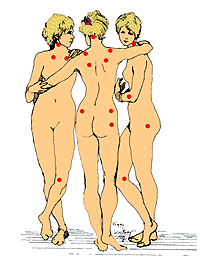|
Fibromyalgia is a chronic disorder characterized by widespread musculoskeletal pain, fatigue, and multiple trigger points or tender spots in precise areas located in all four body quadrants. Eighteen sites usually are found in clusters around the neck, shoulder, chest, hip, knee, and elbow region. People with this syndrome also may experience sleep disturbances, morning stiffness, irritable bowel syndrome, anxiety and depression, headaches, TMJ (temporomandibular joint), and environmental sensitivities (to toxins, allergens, noise, and temperature). |

The 18 Tender Point Locations of fibromyalgia
(The Three Graces, after Baron Jean-Baptiste Regnault, 1793, Louvre Museum, Paris)
|
Reprinted from ARTHRITIS & RHEUMATISM Journal, copyright 1990.
Used by permission of the American College of Rheumatology.
|
Who Is Susceptible?
It is estimated that 6-8 million people in the United States suffer from fibromyalgia. About 80% occurs in women of childbearing age but children, the elderly, and men also can be affected.
What Causes Fibromyalgia?
The cause of fibromyalgia remains unknown but it is believed certain things can trigger its onset. For example, the trigger may be a traumatic event or injury affecting the central nervous system (like a car accident) or a development of another disorder (like rheumatoid arthritis, lupus, or hypothyroidism). Other theories under investigation are viral and bacterial infections and/or increased levels of a protein called "Substance P" that involves a miscommunication of pain, touch, and temperature from the body to the brain.
What Are the Signs And Symptoms?
Pain is the primary symptom in 100% of the cases. It is characterized by widespread pain of 3 months duration or more and pain in 11 of the 18 "tender points." A tender point is a pressure point that feels sore when pressed. Overall pain can feel like you have the flu, just a generalized dull ache and weakness. The pain can be aching, burning, throbbing, or move around the body. The pain often is worse in the morning, improves throughout the day, and worsens at night.
How Does a Hair Tissue Mineral Analysis Assist?
Unfortunately, there is no cure for fibromyalgia. Yet this does not mean it cannot be managed effectively. Many individuals have found relief for specific fibromyalgia symptoms, and by improving their overall health, many people have been able to make their condition go into remission.
Getting a hair tissue mineral analysis can help determine a persons' mineral content and metal toxicities. (See hair analysis.) There is a growing interest in the importance of calcium and magnesium in fibromyalgia. With its mild anti-stress, tranquilizing effects on the body, magnesium can help relax skeletal muscles. Chronic deficiencies of magnesium have been linked with muscle pain. Together with calcium, magnesium also aids in proper muscle contraction. Hair analysis on fibromyalgia patients revealed higher than normal levels of calcium and magnesium, indicating the possibility that these minerals are not being absorbed properly in the body. This also means supplementing these patients with calcium and magnesium!
Selenium is another critical nutrient that can help protect the body from toxic heavy metals and decrease oxidative stress.
Exposure to heavy metal toxins also may play an important role in triggering or exacerbating chronic symptoms of fibromyalgia. Many classic symptoms resemble signs of heavy metal toxicity—including fatigue, neuromuscular pain, depression and anxiety, and sleep disorders.
What Are Other Forms of Treatment?
In addition to a nutritional protocol specific to a person's hair analysis results, others have used methods such as chiropractic manipulations, deep tissue massage, acupuncture, acupressure, relaxation/biofeedback techniques, physical therapy, or gentle exercise programs. Incorporating a detoxification protocol to enhance liver and kidney function and remove any heavy metals and environmental toxins can be extremely helpful. An added benefit to detoxification protocols is numerous anti-aging effects. (See detoxification programs.)
If you have any questions or comments about fibromyalgia, please contact Dr. Akin.
|


